Dewey 21C: February 2009 Archives
Mr. Osborne was providing his vision for the elementary schools in the district. My daughter Sophie, is three and a half, and will be entering kindergarten the year after next, so I thought it would be a good idea to check out what the superintendent had to say.
There were three things that struck me:
1. Osborne recognizes the importance of a well-rounded education to the parents, and is committed to maintaining a broad curriculum that includes the arts, even in the face of NCLB and other accountability trends. I have rarely heard a school administrator state this in a more natural, respectful, and convincing manner. It was also a moment of proof as to what parent engagement and activism can make possible. Yes, the parents in this community want the arts and know how to make themselves heard in a productive way.
2. Osborne had a very grounded view of teacher professional development. First of all, he believes in it, which is refreshing. Second of all, while he recognizes the need to have better data to help guide instruction and professional development, he strikes a very good balance between the two, and is very much in line with great minds in staff development, such as Tony Alvarado and Linda Darling Hammond, recognizing the need to invest in the creation of strong learning cultures within the school. This would include curriculum developed by teachers, in conjunction with professional development, rather than seeking off the shelf, purely external resources.
3. He was so very adept at bringing people together. A number of parents came with their particular complaints, naturally, which could have easily gotten out of hand. He was very skillful in hearing them out and responding, without fanning the flames, or being run over.
Take away: It was interesting, in some ways it was a throwback to education of the past, in that it was very much grounded in the art of teaching and learning, respectful to educators, parents, and students, while addressing content, skills, process, equity, and the use of data/assessment, in ways that seem both beautiful and almost quaint up against the trends in school reform today (data, charter schools, anti-union, etc).
It made me wish that his vision for a well-rounded education, including the arts, would be the vision for every child in every school.
One final observation: parents spoke of "everyday math," the math program the district uses, which is out of the University of Chicago. (I guess we're all Chicagoans for the time being.) Parents asked for help in understanding their kids homework, and Osborne spoke of how this program moves beyond basic numeracy to place mathematics in a more skills-based setting tied to real world/everyday practice and use.
You know, when I was a kid, the parents were all freaking out over what was then called "The New Math." All the parents were complaining about not understanding it. Wow...was this big-time deja vu!
If you want to get a great sense of the churn of school reforms, and how yesterday's "New Math," becomes today's "Everyday Math," how the progressive education of the 40's, which was in many ways a perversion of Dewey's philosphies, becomes the "skills-based" education of today, run don't walk to get a copy of Left Back, by Diane Ravitch.

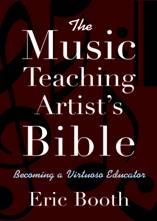
Music has its Mr. Rock n Roll: Alan Freed.
Television has its Mr. Television: Milton Berle.
Arts Education has its Mr. Arts Education: Eric Booth.
Eric has really gone and done it now--he's written what is essentially the big book of teaching artistry: The Music Teaching Artist's Bible--Becoming a Virtuoso Educator
Click here to read more about and purchase it.
This was a great opportunity to pitch a few questions to my good friend Eric. Five questions plus a bonus question for good behavior:
EB: One of my goals has been to contribute to the building of the profession of teaching artistry. We have come a long way. It has bothered me for a long time that there is no foundation text about teaching artistry. We have an increasing number of places for interested people to go to learn about TA-dom, and what the work is like, but a book, as old tech as that rectangular thing is is, still has a surprising legitimating power. My main purpose was to get a first book out there, and I felt a respected mainstream publisher was particularly important for bolstering our legitimacy. Second, I had an old-fart's impulse to pull together what I have learned through a lot of years of insanely hard work and learning to save others the effort. I guess I am trying to become a good ancestor. Frankly, I hate writing books, but I like having written them. I also believed that if I/we could impress the publisher with good sales, it would help establish the field as a legitimate market, and more books would follow. In commercial America, this is an important step in building a field. One of the compromises I had to make to get this out was to use the lens of music in this book, when it is actually written for, and applicabale to, all disciplines.
2. How long did it take and how would you describe your particular process, from concept/genesis to published form?
EB: Most of the chapters are derived from the Edifications column I have written in Chamber Music Magazine for a number of years; so a lot of the raw material was there. Even at that, the writing, expanding, rewriting process took almost a year, and the stuff that goes with completing a book, and getting it out into the world took most of an additional year. All of this for royalties that probably wouldn't get me a quick long weekend trip to London.
EB: There are several chapters on the history of TA-dom. I feel TAs were in pretty much the "go into classrooms and create magic" role until the late '80d/early '90s. Not a bad role, but one with more fairy dust than educative cohones. The layering on of new responsibilities for TAs began with the standards movement, and the assessment demands, and effective partnering, and facilitating, and integrated curricular design work. We now have a spectrum of TAs, from those who still prefer the older in-and-out, lower-commitment model, to deeply skilled masters of this medium. Teaching artists who can deliver all the goods, right up to working in a variety of settings and audiences, being effective advocates, are among the most essential and inspiring humans I know. I think what master TAs know and can do is exactly the elixir that can revive dessicated schooling and transfuse relevance back into the arts for a majority of Americans.
4. What are some of the more advanced developments that teaching artists have made that surprise you?
EB:One frontier is coordinating the various strands of our work to have the sum equal more than the disparate parts. In The Music Teaching Artist's Bible, I propose a set of teaching guidelines that try to start a conversation about what makes the teaching of teaching artists distinctive. We are great at saying there are forty important things TAs accomplish, and we are unable to say there are four key things TAs accomplish. We can talk passionately for fifteen minutes or fifty minutes about teaching artistry, and we suck at distilling it to two minutes. We are just not known up enough as a field yet to have distilled and taken collective agreement about who we are. We will never have complete agreement (I hope), but a step in a growning field is knowing where the agreement lies and being able to present it compellingly.
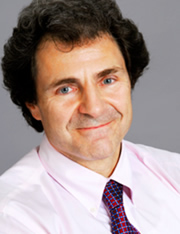
 The future of music doesn't need a coalition, thank you, iTunes will do just fine.
The future of music doesn't need a coalition, thank you, iTunes will do just fine. Actually, it's not just iTunes, it's Garageband (apple again!), YouTube, iVideosongs.com, and even Amazon.com.
And, even in a recession, guitar sales are up 3%.
Click here to read: Apple Makes Online Music Lessons Easy with GarageBand, USA Today.
"Apple's high profile -- and heavy promotion of the video lessons within its 250 retail stores -- brings the idea of learning music online to higher prominence. "It's a fantastic idea, and I hope they do more," says British guitarist Justin Sandercoe, who offers free video lessons at Justinguitar.com. "The idea you can have the guitar lesson with the actual artist who wrote the song is terrific. Now, a great artist may not be a great teacher -- they won't be familiar with the act of teaching -- but the fact is, it's Sting teaching you Roxanne."
The pop world has quite the head start, but it's only a matter of time before more tradtional forms charge forward beyond Youtube. Wow, this article gives me a lot of ideas...
Click here to access it.
The USDOE has also unvieled a section on its website to explain the education portion of the Act.
Click here to access it.
The web resources here provide state-by-state estimates on the various allocations by category, such as Title I.
Speaking of Title I, that may be another area that can help support arts education in the schools. Use varies by state, but in many places Title I has been used to support arts education and ELL, for example.
 Okay, by now, if you haven't heard about the passage and signing of the American Recovery and Reinvestment Act of 2009, there's no hope for you at all.
Okay, by now, if you haven't heard about the passage and signing of the American Recovery and Reinvestment Act of 2009, there's no hope for you at all.While the arts field is focused on the $50 million allocated to the National Endowment for the Arts, including the efforts necessary to secure, and subsequent questions about the future of arts advocacy (click here to read Greg Sandow's column in the Wall Street Journal: The Arts Need Better Arguments), I remain focused on the education portion of the stimulus package.
Simple math:
$50 million for the National Endowment for the Arts
$100 billion for Education
Of the $100 billion, $5 billion has been set aside as a fund to support innovation, including $650 million for school districts or districts in partnership with non-profit organizations. This fund is at the discretion of Arne Duncan, Secretary of Education.
Now, of course this means organizations such as charter school operators, but presumably there is an opening for innovative work by arts education organizations in partnership with school districts. It is not that far off the beaten path of arts education programs currently run by the USDOE. It is a crowded field and the clearly the funding is targeting the improvement of student achievement. Nevertheless, there is an opportunity here to advance education and the arts.
As for the rest of the $100 billion, much of which is going towards staving off teacher layoffs, renovation of school facilities, etc., there may also be opportunities for arts education.
TARP is the first national study to examine the world and work of teaching artists. The goal of TARP is to "deepen our understanding of the lives and work of teaching artists through studies in 12 communities, and it will inform policy decisions designed to make their work sustainable, more effective, and more meaningful."
We all know that teaching artists are a central part of the overall arts education ecology. But, think about it, how much do we really know about them as part of this ecology? TARP seeks to advance the field through this project.
TARP is being conducted by the major research center NORC at the University of Chicago. Its principal investigator is my friend Nick Rabkin, a founder of the Chicago Arts Partnerships in Education, a contributor to Champions of Change: The Impact of Arts on Learning, and author of Putting the Arts in the Picture: Reframing Education in the 21st Century. He is the former director of the Center for Arts Policy at Columbia College Chicago. TARP is supported by 25 foundations and state and local arts agencies.
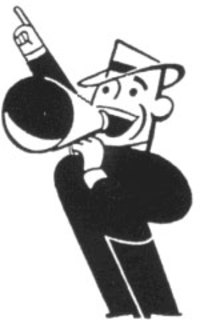
 "With the arts and music among the many industries being hit hard in
economic downturn, U.S. Rep. George Miller (D-CA), chairman of the
House Education and Labor Committee, today announced plans to hold a
series of hearings this Spring to examine how the arts benefit the
nation's economy and schools - and what can be done to improve support
for the arts and music fields. "
"With the arts and music among the many industries being hit hard in
economic downturn, U.S. Rep. George Miller (D-CA), chairman of the
House Education and Labor Committee, today announced plans to hold a
series of hearings this Spring to examine how the arts benefit the
nation's economy and schools - and what can be done to improve support
for the arts and music fields. "And the arts sector was worried about a measly $50 million to the NEA.
Here ya go, details on what the Senate and House bills contain for the Education portion of the Stimulus Bill. There's a lot here, and hopefully, fingers crossed, a lot that could help arts education.
 Under the Senate package
passed yesterday, K-12 schools, colleges and Prek programs would garner over
$80 billion in stimulus funding.
Under the Senate package
passed yesterday, K-12 schools, colleges and Prek programs would garner over
$80 billion in stimulus funding.The total package came in
at $838 billion which received only three Republican votes. In comparison, the
House package is $819 billion and includes substantially more money for school
construction and direct aid to states. The two bills are being reconciled.
Originally, the Senate bill
as approved by the Appropriations Committee last January included approximately
$140 billion in education funding, about equal to the present House bill.
Only three Republicans voted for the bill yesterday: Sen. Olympia Snowe (Maine), Sen. Susan Collins (Maine), and Sen. Arlen Specter (Pennsylvania).
The House versus the Senate bills
The House bill would provide $14 billion for school construction and $79 billion for stabilization funding to the states, the majority of which is for education.The Senate eliminated $16
billion in school construction funding included its original bill, and reduced
the state stabilization line to $39 billion.
The Senate and House measures would provide $1 billion for education technology.
A total of $2 billion in
Title I money is in both the Senate and House versions, including school
improvement grants to be used for schools failing to meet mandated targets in
NCLB.
The Senate bill would cut
to $12.4 billion the approximately $13 billion dedicated for Title I programs in the House bill
for fiscal years 2009 and 2010.
The House's version of the stabilization
fund would include $15 billion in "incentive grants" for states, districts, and
nonprofit organizations, and $25 billion in aid to states that could be used
for a variety of purposes including education.
The Senate's version of
the state stabilization line would include $7.5 billion to states as grants to
incentivize meeting certain school performance measures and funding for local districts
and public colleges/universities, all distributed through existing state and
federal formulas; and flexible funding that could be used for education and
other purposes.
Head Start would receive
about $1 billion in the Senate bill and $2.1 billion in the House version. "Teacher
quality grants" to the states would be $50 million in the Senate; $100 million
in the House.
The House bill has some
other assorted and sundry items not included in the Senate bill: $250 million
for state-run data systems; $25 million in funding for charter school
facilities; and $200 million for the Teacher Incentive Fund, which funds alternative
pay programs.
Importantly, the Senate bills would allow Secretary Arne Duncan to waive what is called "maintenance-of-effort provisions" for the Title I money, special education, and other education programs during fiscal years 2009 and 2010. Maintenance of efforts provisions require states to keep up past funding levels and not use the funding to offset reductions in their own spending.
Richard
************************************************************************************************************
Introduction: This is my first entry as a guest blogger on Richard Kessler's Dewey 21C site at ArtsJournal. I've chosen the title Cliff Notes as a metaphor and a double entendre: first, to represent short takes on long-standing and complicated issues, and second, to provide a verbal image of the perpetually perilous state of the arts as an essential part of general public education.
Notes from
the cliff may be a good way to teach and
learn these digital days. I'm accustomed to writing books, essays and lengthy
articles; I am hoping that the "notes" form will focus my message, and shed
some light on the many challenges we face and their possible solutions. Most of
all, I hope they stimulate a thoughtful dialogue.
My message
is simple: The arts are fundamental to the cognitive, affective, physical, and
intellectual development of all our children and youth. They are a moral imperative. They belong with
the 3 R's, science, and social studies in elementary and secondary schools.
These schools treasure good quality instruction that inspires informed,
resilient young citizens to
participate fully in a democratic society that is in constant flux.
The problem
is complex: The arts in
We are at
another rocky turning point in our history that threatens the survival of the
arts in our social and school systems. The timing and magnitude of our straits have
prompted me to identify what I see as
the most persistent issues I've encountered within the arts education field
over the last forty-plus years.
So, to start the conversation, here
is my first Cliff Note: The Arts as
Pork. On February 6, 2009, the U.S. Senate approved an amendment to the
economic recovery bill offered by Sen. Tom Coburn (R-OK) that stated "None of
the amounts appropriated or otherwise made available by this Act may be used
for any casino or other gambling establishment, aquarium, zoo, golf course,
swimming pool, stadium, community park, museum, theater, art center, and
highway beautification project." The
amendment passed by a vote of 73-24, and included support from many high
profile Senators from
I cannot think of a better example
of what happens to the arts (in general, and in education) when the political
and socio-economic stakes are high and the going gets rough. Here, the arts
became pork along with gambling, sports, public parks and so on.
Question: Where is the army of
indignant protesters in our schools and the larger society willing to storm the
barricades? Think on it. There will be
many more questions to come.
*******************************************************************
 Jane Remer has worked nationally for over
forty years as an author, educator, researcher, foundation director and
consultant. She was an Associate Director of the John D. Rockefeller 3rd Fund's
Arts in Education Program and has taught at Teachers College,
Jane Remer has worked nationally for over
forty years as an author, educator, researcher, foundation director and
consultant. She was an Associate Director of the John D. Rockefeller 3rd Fund's
Arts in Education Program and has taught at Teachers College, However, there's an whole other side to this, to be found in the education portion of the package, which I am afraid for the moment doesn't look very good.
The bad
news is this: the Senate version of the "compromise" bill to be voted
this week by the Congress slashes $40 billion, or 23% from
the funding designed to help states avoid drastic education cuts and teacher
layoffs , and eliminates the flexibility which would allow NYC to
use these funds to offset state or city budget cuts.
In New York City, as an example, this means that more
than half of all NYC public schools could face reductions of up to 16% next
year. Cuts of this magnitude will not only force teacher layoffs, but the funding for services of cultural organziations would be devastated, including teaching artist residencies, field trips, professional development, etc.
It's also important to consider, again using New York City as an example, that approximately 30% of the public schools have no certified arts teachers whatsoever, and are therefore more dependent upon cultural organizations for arts education instruction than schools with arts teachers.
The "compromise" bill also completely eliminates the $19.5 billion program for school construction.
As for "riots in the streets," (see previous post), it's clearly hard to imagine people rioting over a change to mayoral control. These prospective cuts however, do make you wonder how 10,000 teachers being laid off in New York City will be received.
More to follow...
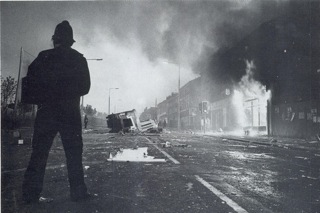

I blogged twice about this over the past few months, in case you want to take a look in the archives.
Nevertheless, what we have here is a $7 million mid-year cut, on top of an already implemented 10% cut, totaling a 20% cut for this year alone. The critical blow, a hallmark of bad government, is that because of the timing of the mid-year cut, it will only effect those who have not yet received their grant payments. So, for those who were in the October or December panels, you received ZERO. That's correct zero. Those who received awards in earlier panels have already received their funding. That's what I mean by "bad government."
Bear in mind, what's happening here has nothing to do with NYSCA as an agency, it is all in the hands of the Governor and State Legislature.
The potential salve, which doesn't quite add up, is that the the deficit reduction bill directing the mid-year cut includes language which would in effect place grantees who were in those last two panels, and zeroed out, first in line next year before any new grants are considered.
In theory that sounds well and good, but there's already a proposed budget for next year which combined with this year's cut, would result in a 40% cut to NYSCA if approved. All things considered, the overall cuts to NYSCA may make it very difficult for this change in the timing of grant consideration for next year to have much practical effect. Either way, it's going to be tricky for NYSCA, and horrible for the grantees and all of those who benefit from the activities that NYSCA's support make possible, such as kids in schools without any arts teachers.
I hope this post makes some sense. It's a bit tricky to explain in relatively brief terms.
I will keep you posted.
Coburn's fifth amendment to the Stimulus Bill isn't exactly an ad hominen objection to the arts in the bill, more precisely it reads:
"5. No funds shall be used for casinos, aquariums, zoos, museums, golf courses, or swimming pools (mirror House language)."
Click here to see what the Performing Arts Alliance is already doing to try and counter this amendment.
Click here for the transcript and video
The highlights of her presentation are as follows:
"So, the Department of Education is going to be at the forefront of many of the things that we have to do in this administration, and we're going to need that energy in these times of economic challenge.
We're going to be making investments. And I shouldn't say "we," but the administration "we."
With these investments, we're going to create good jobs as we renovate and modernize more than 10,000 schools and improve the learning environment for about 5 million children across this country.
We'll be able to increase Pell grants and make college more affordable--for 7 million students and give nearly 4 million students tax credits for tuition. Imagine that.
And with these investments that we hope to make through this stimulus package, we'll be able to prevent teacher layoffs--and education cuts in hard-hit states.
You know, we need to keep teachers in the classrooms throughout this time. We'll be able to preserve early childhood education programs.
And I know all of you here know the importance of investing in early childhood education. Imagine what we can do with millions of dollars of more investment in this area.
We can expand opportunities in low-income districts for all students and particularly for students with disabilities.
And then, as we look over the longer term, these investments will accelerate education reform, one of Arne's specialties, by funding and rewarding innovation-- innovative approaches to teaching and learning, such as teacher quality initiatives, school turnaround programs, and, of course, charter schools."
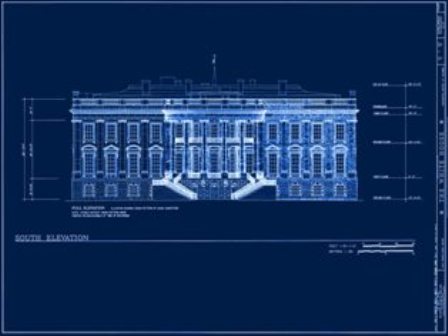
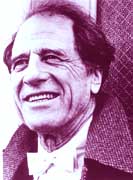
Foss was a powerhouse of a talent: conductor, composer, pianist. The glory days of the Milwaukee Symphony, Buffalo Philharmonic, and Brooklyn Philharmonic, were all tied to Foss's tenure, one that highlighted new music.
He had a reputation for sight reading the most difficult new scores at a first rehearsal, which some found to be a hallmark of genius, while others found it less than respectful to the composer in particular.
When they say they don't make 'em like they used to, that was certainly the case with Lukas Foss. Want to discover the genius of his work as a composer: listen to Time Cycle:
In it's orignal version for orchestra;
In its chamber version.
It is a masterpiece.
"I strongly suggest that we play down basics like who influenced whom, and instead study the way the influence is transformed, in other words: how the artist made it his own."
Lukas Foss
"To come to grips with creativity, I must ask creative, adventurous questions - the kind which, in all likelihood, cannot be answered."
Lukas Foss
"Anybody can put things together that belong together. to put things together that don't go together, and make it work, that takes genius like Mozart's. Yet he is presented in the play Amadeus as a kind of silly boy whom the gods loved."
Lukas Foss
 The Perpich Center for Arts Education's State Arts High Schools,has, for quite some time now, been a very important model for arts centered high schools, while also serving as one of the nation's most important centers for K-12 arts education.
The Perpich Center for Arts Education's State Arts High Schools,has, for quite some time now, been a very important model for arts centered high schools, while also serving as one of the nation's most important centers for K-12 arts education.Governor Tim Pawlenty has submitted a budget which cuts away $2.2 million of a overall budget of $7 million, while eliminating "outreach" efforts and converting the high school to a charter school.
This would be a loss for the entire field of arts education.
Read the Statement by The Perpich Center on the proposed cuts.
Read "State Arts School Fights to Survive"--Startribune.com
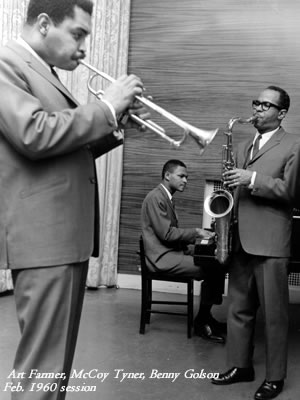
It's a lovely recording that answers his question in a way that one would expect from a real master and living history of jazz from Coltrane to today.
And, there's a recent interview on NPR, where his generosity, positive spirit, and humble nature are nothing short of inspirational. That interview is arts education.
There are plenty of examples of classical composers weaving a bit of jazz into their composition, from Gershwin, to Milhaud, Ravel, Hindemith, Copland, and others. But mainly these are moments where jazz is referenced or inserted in what is clearly a classical piece.
Of course, there are many composers who have included improvisation in their primarily classical compositions, dating back to the Baroque all the way through Witold Lutoslawski, John Cage, Earle Brown, and many others. The composition here isn't jazz, it's falls into a broader classical genre that uses improvisation.
There was Gunther Schuller's Third Stream, an amalgam of classical and jazz composition. While it was conceived in the late 50s, and big for a while in the 70s, it looks like its more a part of music history books than a real "stream."
There are jazz artists who compose in a distinctly classical/concert music style, such as Keith Jarrett. His formal, through-composed works more resemble Shostakovitch than anything he does while improvising at the piano or with his trio. Have you ever heard his Paris Concert or Koln Concert? Marvelous stuff.
There's the late, great John Lewis, composer, pianist, and member of the Modern Jazz Quartet. Perhaps no one single person best personifies work crossing in and out of then nexus between jazz and classical music better than John Lewis.
He made two albums with his wife, the harpsichordist Mirjana Lewis, where she played a movement of Bach's Goldberg Variations, and then John responds with an improvisation, a reflection of the movement just heard. The recording alternates throughout in that manner. Lewis also made a recordings of Bach's Well Tempered Clavier, which were a combination of the notes written by Bach as well as his own improvisation mixed in. I remember the first time I heard it--I loved it. In addition, Lewis founded Orchestra U.S.A., which was a big band that among other things, performed Lewis's Third Stream works.

